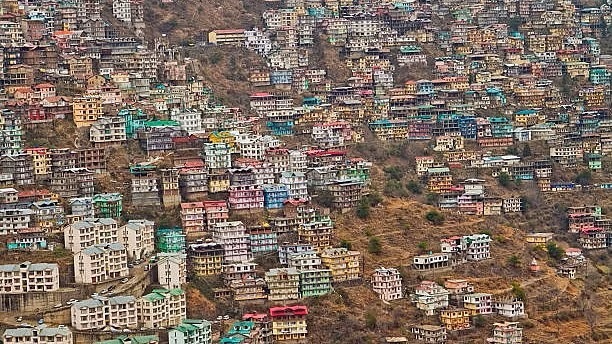
Spot the tree, challenges author Avay Shukla, (photo courtesy Kris G. Hariharan and Avay Shukla)
I
t would appear that Himachal’s first-time chief minister Sukhvinder Singh Sukhu has made a fairly good start to his innings, which is just about six months old.
He has kept the old guard and the party eminences in good humour, implemented some of the campaign promises, rolled back a few BJP decisions and initiated steps to augment the revenues of the state, reeling from a debt of more than Rs 70,000 crore.
But I must confess that I am sorely disappointed with his government in one important respect: he has turned a blind eye to the progressive ruin and destruction of the state’s natural environment, and is following in the disastrous footsteps of his predecessors.
Indian politicians have mastered what V.S. Naipaul, in his book An Area of Darkness, terms ‘the art of non-seeing’. How, otherwise, do you miss the writing on the mountain walls—the loss of forest cover, the rapid melting of glaciers (a recent ICIMOD report says that 80 per cent of Himalayan glaciers would have vanished by 2100), the risk of flooding by bursting of glacial lakes (GLOF), the rampant over-construction and over-tourism that is not only devastating the landscape but also endangering the state’s residents? Didn’t Uttarkashi teach us any lessons? What’s all the hollow rhetoric about making Himachal a ‘green state’ (whatever that means) and becoming ‘carbon neutral’ when no policy decision or action on the ground bears any evidence of fashioning a new paradigm of sustainable, environment-friendly ‘development’.
Let me focus on just three major areas to prove my point:
The biggest disaster in the making is the recently notified Shimla Development Plan 2041 (SDP41).
This astounding piece of bureaucratic ignorance and apathy is a death warrant for Shimla and thousands of its residents, living as they do in a seismic zone 4 area. It permits construction in hitherto prohibited areas—the core and heritage zones. It allows five floors in the non-core areas, where currently only 2+1 floors are allowed. It will, after more than 20 years of strict prohibition, enable people (read: builders and hoteliers) to construct in the only remaining green lungs of Shimla—the 400 hectares of forest that makes up the Green Belt of the town.
Read Madhav Gadgil in The Beacon:
The stated objective of SDP41 is to treble—yes, treble!—the town’s population (from 2 lakh in the 2011 census to 6 lakh by 2040). A town that even now cannot provide parking for residents and tourists, where it takes 30 minutes to move 2 kilometres. A town that suffers an acute shortage of water every year. A town where dead bodies have to be carried over rooftops in certain areas because the lanes are not wide enough. A town that was once a pedestrian’s delight but where you now walk at your own risk. A town where there are 20,000 irregular buildings already, since no government has mustered the political will to take action against them.
Each and every one of these provisions has been incorporated against the advice of the government’s own expert committees and objective town planners.
The National Green Tribunal (NGT) had struck down this SDP41 in 2018. The state high court too quashed it a couple of years later, dismissing the state’s appeal. The previous BJP government had filed an appeal in the Supreme Court, which passed a strange order this May—without going into the merits of the case, or reasons on the basis of which both the NGT and high court had struck down SDP41, it allowed the government to notify the new plan, with the caveat that the government would not act upon it for a month thereafter!
The state government may not act upon it just yet, but you can be sure that the builders have already started acting on it. We are becoming inured to puzzling orders from the apex court, but this one takes the cake, if not the bakery. Why not maintain status quo till the case is finally decided on merit? Has the court, too, forgotten Uttarkashi so soon?
![]()
In Himachal, more coming. Representational Image courtesy: Wikimedia
One had expected that the new state government would withdraw the state’s appeal in the Supreme Court, and respect and abide by the decisions of the NGT and the high court, especially now that no elections are due for the next five years. But it is apparent that even the current government is not able to withstand the pressure from the builders’ lobby.
Someday, the residents of Shimla will pay for this in blood, broken bones and shattered dreams. But who cares as long as the EVMs churn out the right numbers?
In The Beacon: FROM A ‘COMMUNITY OF BEINGS’ TO ‘THE ECONOMY OF VIOLENCE’ AND…BACK?
The second issue that concerns the state’s environment is the reckless obsession with building and widening roads, without any care for the fragile terrain or the large-scale displacement of people it causes.
As many as 69 national highway projects have been approved, of which five are four-lane highways—on the Shimla–Mataur, Pathankot–Mandi, Kiratpur–Manali and Parwanoo–Shimla routes.
These may be good news for Mr. Gadkari’s annual targets, or for the coffers of politicians and engineers, but they are the last things Himachal needs. Four-laning in mountainous terrain is enormously destructive, causing deforestation and landslides for years.
The Parwanoo–Shimla highway was declared completed in 2021 after five years’ delay, but landslides continue even today, closing down two lanes for months. It is no coincidence that this particular national highway and the Manali highway were the worst affected by torrential rains in the second half of June this year, leaving thousands of commuters and tourists stranded for as long as 24 hours at a stretch.
This happens every year, and the government just keeps adding more such projects every year. It should give up this four-laning madness and focus instead on improving district rural roads.
Even otherwise, the mountains do not need four-lane highways. They increase vehicular traffic exponentially (Shimla Police records show that vehicles entering Shimla this year have gone up by 25 per cent), causing pollution, traffic jams and clogging the towns where there is just no space to park so many vehicles.
Shimla has parking for 6,000 vehicles, but up to 20,000 arrive from outside every day during high season (these are in addition to the 100,000 or so locally registered vehicles.).
The result? Shimla police say 60,000 vehicles are parked on the roads in an unauthorised fashion, and it takes an average of 90 minutes to go from one end of the town to the other, a distance of barely 7 kilometres.
Things are exactly the same in Manali, Dharamsala, Solan, Palampur, Kasauli; 10,000 vehicles cross the Atal tunnel every day—all tourists! It is simply not feasible to construct supporting infrastructure for these numbers in this kind of terrain. We should be discouraging more vehicles entering the state. Four-laning of highways will only encourage more and more vehicles to crowd the roads and cities, making them unliveable.
One expected the new chief minister to roll back this madness, but instead he has requested the Centre for more such roads!
The ambitiously christened Mandi International Airport is another disappointment. There is no need for this quixotic project: if all three existing airports in the state function below 50 per cent of their capacity, why build another one? Especially when the environmental and social costs are enormous, in terms of felling thousands of trees, concretising hundreds of acres, diversion of streams and displacement of a thousand farming families.
Even the financial costs are staggering—Rs 5,220 crore—for a state that has a debt overhang of Rs 80,000 crore and finds it difficult to pay salaries and pensions on time. But is the state government listening?
This state of affairs only shows that politicians, no matter which party, don’t give a damn about the environment.
Nor does the voter, it seems.
Also Read: In Uttarakhand, Crores in the River
It is we, the people, who are to blame for not calling them out, for being content with short-term benefits, for lacking a vision that will serve future generations, and for not making this precious natural heritage an election issue.
We forget that we have not inherited the natural environment from our ancestors, we have it on loan from our children and have to return it to them. We are defaulting on this loan on a massive scale.
******
Courtesy: National Herald: Published: 11 Jul 2023, 6:33 PM Original title: …and now, Himachal is courting disaster https://www.nationalheraldindia.com/environment/more-mayhem-in-the-mountains
 Avay Shukla retired from the Indian Administrative Service in December 2010. He is a keen environmentalist and loves the mountains. He divides his time between Delhi and his cottage in a small village above Shimla. A keen environmentalist and trekker he has published a book on high altitude trekking in the Himachal Himalayas: THE TRAILS LESS TRAVELLED. He used to play golf at one time but has now run out of balls. His second book- SPECTRE OF CHOOR DHAR is a collection of short stories based on the myths and fables of Himachal and was published in July 2019. His third book was released in August 2020: POLYTICKS, DEMOCKRAZY AND MUMBO JUMBO is a compilation of sarcastic, humorous and in-your-face blogs and articles on the state of our nation.
The author in thebeacon.in.
Avay Shukla retired from the Indian Administrative Service in December 2010. He is a keen environmentalist and loves the mountains. He divides his time between Delhi and his cottage in a small village above Shimla. A keen environmentalist and trekker he has published a book on high altitude trekking in the Himachal Himalayas: THE TRAILS LESS TRAVELLED. He used to play golf at one time but has now run out of balls. His second book- SPECTRE OF CHOOR DHAR is a collection of short stories based on the myths and fables of Himachal and was published in July 2019. His third book was released in August 2020: POLYTICKS, DEMOCKRAZY AND MUMBO JUMBO is a compilation of sarcastic, humorous and in-your-face blogs and articles on the state of our nation.
The author in thebeacon.in.

Leave a Reply